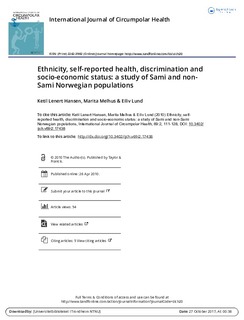| dc.contributor.author | Hansen, Ketil Lenert | |
| dc.contributor.author | Melhus, Marita | |
| dc.contributor.author | Lund, Eiliv | |
| dc.date.accessioned | 2017-06-07T12:37:00Z | |
| dc.date.available | 2017-06-07T12:37:00Z | |
| dc.date.issued | 2010 | |
| dc.identifier.citation | Hansen, K.L., Melhus, M. & Lund, E. (2010) Ethnicity, self-reported health, discrimination and socio-economic status: a study of Sami and non-Sami Norwegian populations. International Journal of Circumpolar Health, 69(2). | |
| dc.identifier.uri | http://hdl.handle.net/11250/2444924 | |
| dc.description | Vitenskapelig artikkel som utforsker sammenhengen mellom etnisitet, sosiale faktorer og selv-rapportert helse i samiske og ikke-samiske populasjoner i Norge. | |
| dc.description.abstract | Objectives: investigate the association between ethnicity, social factors and self-reported health conditions of Sami and non-Sami Norwegian populations. Study design: cross-sectional questionnaire. Methods: SAMINOR is a population-based study of health and living conditions that was conducted in 24 municipalities in northern Norway during 2003 and 2004. The present study included 12,265 individuals aged between 36 and 79, whose ethnicity was categorized as Sami (33.1%), Kven (7.8%) and Norwegian majority population (59.1%). Results: Sami respondents reported inferior health conditions in comparison to the Norwegian majority population. The most unsatisfactory conditions were reported by Sami females living outside the defined Sami area (with greater integration and assimilation) (p<0.05). Females typically reported less favourable health conditions than did males. Health inequalities varied by age and were more apparent in persons aged in their mid-50s or above. Across ethnic groups, respondents with the highest education and household income were healthier than others. Furthermore, those reporting to have been frequently discriminated against were more likely to report poorer health than those who did not; the odds ratios (95% CI) was found to be 2.88 (1.92-4.32) for women and 1.61 (1.08-2.42) for men. When discrimination was included in the logistical model, the increased risk of poor self-reported health decreased to non-significance for Sami respondents. The estimated risk decreased further when the socio-economic status was taken into account. Conclusions: the findings of this study suggest that self-reported ethnic discrimination combined with low socio-economic status contributes to inequalities in self-reported health when Sami and Norwegian majority population are compared. | |
| dc.language.iso | eng | |
| dc.rights | Navngivelse 4.0 Internasjonal | |
| dc.rights.uri | http://creativecommons.org/licenses/by/4.0/deed.no | |
| dc.subject | ethnic discrimination | |
| dc.subject | socio-economic status | |
| dc.subject | self-reported health | |
| dc.subject | ethnicity | |
| dc.subject | indigenous | |
| dc.subject | sami | |
| dc.subject | etnisk diskriminering | |
| dc.subject | sosioøkonomisk status | |
| dc.subject | selvrapportert helse | |
| dc.subject | etnisitet | |
| dc.subject | urfolk | |
| dc.subject | samer | |
| dc.subject | SAMINOR | |
| dc.title | Ethnicity, self-reported health, discrimination and socio-economic status: a study of Sami and non-Sami Norwegian populations | |
| dc.type | Journal article | |
| dc.type | Peer reviewed | |
| dc.rights.holder | Hansen, Ketil Lenert | |
| dc.source.volume | 69 | |
| dc.source.journal | International Journal of Circumpolar Health | |
| dc.source.issue | 2 | |
| dc.identifier.doi | 10.3402/ijch.v69i2.17438 | |

